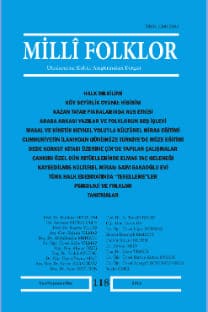PEYGAMBERLER TARİHİNDE BİR KURT HİKÂYESİ
Peygamberlerin hayatları etrafında teşekkül eden olayların anlatıldığı kıssalar, Türk edebiyatın-da önemli bir yere sahiptir. Kaynaklarda her ne kadar kıssa kelimesinin hikâye ile karşılanamayacağı belirtilse de Türk edebiyatında bu iki kelime hemen hemen aynı anlamda kullanılmıştır. Edebiya-tımızda doğrudan doğruya peygamber kıssalarını içeren metinler olduğu gibi; farklı türdeki birçok metinde de bu kıssalara yer verilmiş ve çoğu zaman telmihte bulunulmuştur. Bu çalışmada, Budapeş-te’deki Macar Bilimler Akademisi Kütüphanesi’nde TÖRÖK, Qu. 24 numarasıyla kayıtlı 82 varaktan ibaret Sirâcü’l-Kulûb yazmasının, 77a-b varağında yer alan bir peygamber kıssası konu edilmektedir. Kaynaklarda daha önce benzerine rastlamadığımız ve Hz. Musa zamanında geçtiği ifade edilen bu hikâyenin dikkat çeken en önemli özelliği içerisinde kurt motifinin yer almasıdır. Yalnızca Türk edebi-yatında değil, dünya edebiyatlarında da pek çok anlatma türünde var olan şekil değiştirme motifi, bu hikâyede kurt donuna girmiş melek şeklinde karşımıza çıkmıştır. Makalenin giriş bölümünde öncelik-le, kutsal kitaplardan Kur’an, İncil ve Tevrat’ta da yer alan Hz. Musa kıssası ile ilgili ana hatlarıyla bilgi verilmiş, daha sonra hikâyenin kısa bir özeti yapılmıştır. Ardından kurdun Türk kültüründe tü-renilen, kılavuz, dost, ulu, koruyucu ve ondurucu yönleriyle öne çıktığından bahsedilmiş ve kültürü-müzdeki yeri üzerinde durulmuştur. Bahsi geçen hikâye; hem içerdiği şekil değiştirme, dua ile hamile kalma, Tanrı ile anlaşma, sözünü yerine getirme gibi motifler hem de kadim Türk geleneklerinden izler taşıması gibi yönleriyle son derece ilgi çekicidir. Sonuç bölümünde dil özelliklerinden hareketle Osman-lı Türkçesi döneminin eseri olduğu tahmin edilen bu hikâyenin motiflerinden kısaca söz edilmiştir. Sonuç bölümünün ardından dinler tarihi ve Türklük Bilimi çalışmalarına katkı sağlaması maksadıyla hikâyenin tam metni araştırmacıların dikkatine sunulmuştur.
A Wolf Story in the History of the Prophets
The parables, which narrate the events shaped around the lives of the prophets, have an impor-tant place in Turkish literature. No matter how much it has been stated in the sources that the word parable cannot be covered by story these two words have been used in almost the same meaning in Turkish literature. Just as there are texts in our literature, which directly contain prophet parables, place has also been given and alluded to these parables in many texts of different genres. In this study, a subject prophet parable -which consist of 82 leafs - is located at the Library of the Science Academy of Hungary in Budapest, Hungary, on leaf 77 r-v of the Sirâcü’l-Kulûb handwritten manuscript, which is registered as TÖRÖK, Qu. No. 24. The most important attribute that draws attention to this story, which is said to have happened at the time of the Prophet Moses and of which we have not previously encountered a similar one in the sources, is that it includes the wolf motif within it. The metamorpho-sis, which exists not only in Turkish literature, but also in many narration genres in the world litera-ture as well, confronted us in this story in the form of an angel who has entered into the coat of a wolf. First of all, in the introduction of the article, information was given with main lines about the Prophet Moses’ parables, also included in the Holy Koran, the New Testament and the Torah and then, a short summary of the story was made. Subsequently, it was mentioned that the wolf in Turkish culture ap-peared in the forefront with the aspects of being derived, guide, friend, great, protector and healer and the place in our culture was dwelled upon. The mentioned story is so absorbing in terms of the the motifs such as metamorphosis, keeping one’s word, getting pregnant with prayer, agreement with God and it is interesting in terms of archaic Turkish traditions, too. In the conclusion, which is thought to have been written during the Ottoman period according to the language attributes, the motifs of this story have been mentioned briefly. Finally, the complete text of the story was given with the purpose of providing a contribution to the history of religions and the Turcology studies.
___
- Ahmet Cevdet Paşa. Kısas-ı Enbiyâ ve Tevârih-i Hulefâ. 1. Cilt. İstanbul: Bedir Kitabevi, 1966.
- Aslan, Namık. “Kurt Motifinin Türk Mense Ef-sanelerindeki Anlamı Üzerine”. Millî Folklor 87 (Güz 2010): 51-56.
- Çelebioğlu, Âmil. Türk Edebiyatında Mesnevi. İstanbul: Kitabevi, 1999.
- Durmuş, İlhami. “Destan, Efsane ve Rivayetlere Göre Türk Kültür Çevresinde Kurt”. Dede Korkut ve Geçmişten Geleceğe Türk Destanları Uluslararası Sempozyumu Bildiriler Ki-tabı. Ankara: 2011, s. 65-76.
- Ergin, Muharrem. Dede Korkut Kitabı 1. Ankara: Türk Dil Kurumu Yayınları, 2008.
- Güzel, Abdurrahman. Abdal Mûsâ Velâyetnâmesi. Ankara: Türk Tarih Kurumu Basımevi, 1999.
- Harman, Ömer Faruk. “Mûsâ”. TDV İslâm An-siklopedisi. C.31. s. 207-213. İstanbul: Türki-ye Diyanet Vakfı Yayınları, 2006.
- http://www.ruthenia.ru/folklore/thompson/ (et:18.09.2016 10:37).
- Karasoy, Yakup. Sirâcü’l-Kulûb -Gönüllerin Işığı-. Ankara: Türk Dil Kurumu Yayınları, 2013.
- Köksal, M. Asım. Peygamberler Tarihi. Ankara: Türk Diyanet Vakfı Yayınları, 2011.
- Ocak, A. Yaşar. Kültür Tarihi Kaynağı Olarak
- Menâkıbnâmeler (Metodolojik Bir Yakla-şım). Ankara: Türk Tarih Kurumu Basıme-vi, 1992.
- Oğuz, M. Öcal. “Kul Himmet ve Sözlü Gelenek Tanıklığında Kozmogonik Mitin Eskatolojik Serüveni”. Millî Folklor 84 (Kış 2009): 51-56.
- Ögel, Bahaeddin. Türk Mitolojisi. Ankara: TTK Yay., 2010.
- Ölker, Gökhan. Kıssa-i Musa ‘Aleyhi’s-Selam. Konya: Palet Yayınları, 2013.
- Sirâcü’l-Kulûb. Budapeşte: Macar Bilimler Aka-demisi Kütüphanesi, TÖRÖK, Qu. 24.
- ISSN: 1300-3984
- Yayın Aralığı: Yılda 4 Sayı
- Başlangıç: 1989
- Yayıncı: Geleneksel Yayıncılık Eğitim San. Tic. Ltd. Şti.
Sayıdaki Diğer Makaleler
TÜRKİYE’DEKİ GELENEKSEL SOHBET TOPLANTILARI ÜZERİNE BİR DEĞERLENDİRME
EPİK ANLATILARDA BİR GEÇİŞ METAFORU OLARAK UYKU
MEHMET NACİ ÖNAL, MUSTAFA SARGIN
BÜLBÜL ÖTÜŞÜNÜN ANONİM BİYOGRAFİYE GÖRE ANLAMLANDIRILMASI ÜZERİNE
OSMANLI DEVLETİ’NDE ISLAHATLAR BAĞLAMINDA MUSKA VE FALCILIKLA MÜCADELE ÖRNEKLERİ
KAZAK TÜRKLERİNİN FOLKLOR KAYNAKLARINA GÖRE EFSANEVİ VE GELENEKSEL TAŞITLAR
Amanzhol KALISH, Jazira TEREKBAYEVA
ŞAH HATÂYÎ İLE TAÇLI HANIM HİKÂYESİ
PEYGAMBERLER TARİHİNDE BİR KURT HİKÂYESİ
YAKUP KARASOY, Arife Ece TOMBUL
KARACAOĞLAN VE BUKAR KALKAMANULI’NIN ŞİİRLERİNİN KARŞILAŞTIRILMASI
Bekarys NURİMANOV, Amanzhol ALTAY
SÖZLÜ GELENEKTEN ELEKTRONİK DÖNEME BİLGELİK DÖNÜŞÜMÜ: IRKIL ATA’DAN ŞAHİN AĞA’YA
